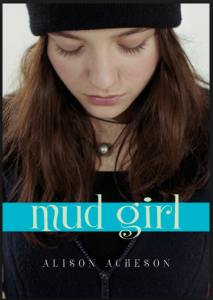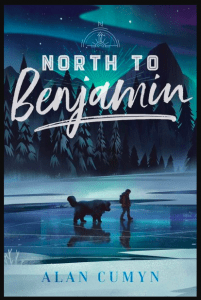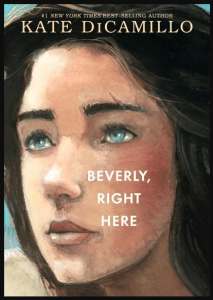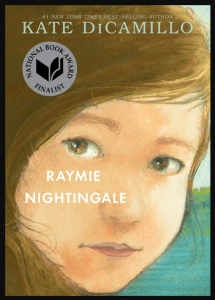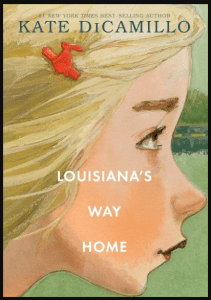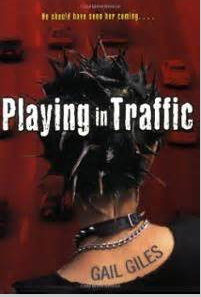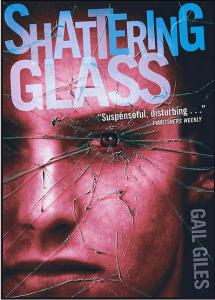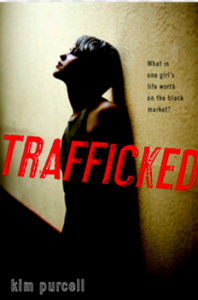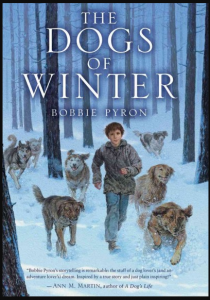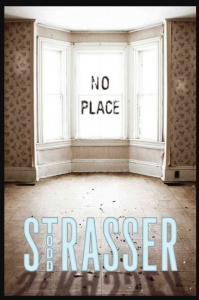Acheson, Alison. Mud Girl. Cotteau Books, 2006.
Sixteen-year-old Abi is lonely. Her mother left a year ago and her father rarely speaks. So when she finds a boyfriend, life seems so much happier. But Jude, in his twenties, already has a young son and he wants his relationship with Abi to go much further than she expected.
Bauer, Joan. Best Foot Forward. New York : Putnam, 2005.
Jenna is busy running between school, Al-Anon meetings, and her job at a shoe store. And life becomes more complicated when her boss, Mrs. Gladstone, hires another teenager: a boy on probation. Who can you trust in life? Can people really change? Readers in grades eight to ten will enjoy this humourous novel with a bit of romance and a lot of angst. [Stores; Old age; Shoplifting; Family problems; Work; Ethics]
Bloor, Edward. Crusader. New York: Harcourt, Inc., 1999.
“After a violent reality game arrives at the mall arcade where she works, fifteen-year-old Roberta finds the courage to search out the person who murdered her mother.” – CIP This award-winning novel is recommended for mature and competent readers in grade eight and up. [Courage; Cousins; Drug abuse; Fathers and daughters; Florida; Murder; Secrets; Shopping malls; Teenagers; Theft; Violence; Young adult fiction]
Bloor, Edward. A Plague Year. Knopf, 2011.
A ninth-grader who works with his father in the local supermarket describes the plague of meth addiction that consumes many people in his Pennsylvania coal mining town from 9/11 and the nearby crash of United Flight 93 in Shanksville to the Quecreek Mine disaster in Somerset the following summer. – CIP [Drug abuse; Young adult fiction; Schools; Pennyslvania; Coal mines and mining; Accidents; Secrets]
Christopher, Lucy. The Killing Woods. New York : Chicken House/Scholastic, 2014.
“When her father, an ex-soldier suffering from post-traumatic stress disorder or PTSD, is arrested for murder, Emily’s efforts to exonerate him take her into the woods to play the Game, an extreme version of childhood games.” – CIP [Fathers and daughters; Games; Mystery and detective stories; Post-traumatic stress disorder; Young adult fiction]
Cumyn, Alan. North to Benjamin. New York: Atheneum Books For Young Readers, 2018.
Edgar is eleven years old. Not only enough to live on his own. But his mother has problems, which don’t disappear even once they move to Dawson, Yukon to start again. Only a dog named Benjamin is able to help rescue Edgar from certain disaster. This heart-breaking yet hope-filled novel by an award-winning Canadian writer is recommended for readers 11 to 16 years old. [Alcoholism; Dogs; Yukon]
Cumyn, Alan. Tilt. Toronto : Groundwood Books/House of Anansi Press, 2011.
Sixteen-year-old Stan likes basketball but he loves Janine. Does Janine care for him, too, or is she gay? His younger sister lives in an imaginative world of her own, his mother has a new boyfriend who seems useless, and his father tries to move back home, sneaking in his young son from his second marriage. All the problems of modern life show up in this new humorous, heart-warming novel by the talented author of the Sylvia series. Recommended for mature readers in grade nine and up due to the sexual references. [Family life; Single-parent families; Teenagers; Young adult fiction; Basketball]
…
DiCamillo, Kate. Three Rancheros series:
Somerville, Massachusetts: Candlewick Press, 2019.
The third in a trilogy about three friends, Beverly, Right Here tells the story of fourteen-year-old Beverly who runs away from home and gets a job in a neighbouring town.
Somerville, Mass.: Candlewick Press, 2016.
The first in the series was Raymie Nightingale, about a girl who misses her father, who hopes if only she can win a beauty contest, he will come home.
Somerville, Massachusetts : Candlewick Press, 2018
The second story was Louisiana’s Way Home in which the main character’s grandmother wakes her in the middle of the night to tell her they’re leaving town right now and never coming back.
Three elegantly written novels, set in Florida, with a consistent theme:
Life is not always the way it should be. Your parents may not have enough energy or enough interest to properly care for you. The people you depend on may not always be dependable. You probably will have to make important decisions all on your own. But there is hope. Someone will come along – even if just for a moment – to give you words of encouragement and wisdom. Life will never be the way you’d hoped it would be, but it will still be good. And remember: you are loved.
Highly recommended for readers 10 to 14 years old.
Elliott, Zetta. Bird. New York: Lee & Low Books, 2008.
A young African American boy draws the world around him while trying to understand his older brother’s drug addiction. This gentle picture book will be appreciated by children and adults. Teachers might like to use it for lessons on reading between the lines, writing in free verse, and dealing with drug abuse. [Brothers; Family life; Drug abuse; Drawing; Novels in verse; Death; Style, Literary – Study and teaching]
…
Ellis, Deborah. Lunch with Lenin and Other Stories. Markham, ON: Fitzhenry & Whiteside, 2008.
“Just say no to drugs,” is a common saying. But how do drugs affect families in Afghanistan and street children in Russia? These short stories offer various perspectives on the war on drugs.
…
Ellis, Deborah. True Blue. Toronto : Pajama Press, 2011.
“The darker side of a friendship is portrayed by Jess, a seventeen-year-old who struggles to find the moral courage to remain loyal to her best friend Casey who has been accused of murdering an eight-year-old girl at summer camp. The town becomes a media circus and the pressures far too great for Jess to cope.” – CIP Recommended for readers in grade eight and up. [Camps; Faith; Friendship; Loyalty; Murder; Peer pressure; Young adult fiction]
Friesen, Gayle. Janey’s Girl. Kids Can Press, 1998.
Fifteen-year-old Claire discovers more than she expected when her mother takes her to visit her maternal grandparents in a small rural town in B.C.’s Fraser Valley.
Gavin, Jamila. See No Evil. New York: Farrar, Straus and Giroux, 2008.
Twelve-year-old Nettie enjoys a wealthy life with her parents in London, England. There are servants, private ballet lessons and travels around the world. But when her favourite tutor mysteriously disappears and she meets the son of a household employee, Nettie starts to suspect that her father’s wealth is coming from trafficking in illegal aliens. Full of suspense, this story may appeal to readers who appreciated The Boy in the Striped Pajamas.
Giles, Gail. Playing in Traffic. New York: Simon Pulse, 2006.
“Shy and unremarkable, seventenn-year-old Matt lathrop is surprised and flattered to find himself signaled out for the sexual attentions of the alluring Skye Colby, until he discovers the evil purpose behind her actions.” – CIP Recommended only for mature readers in grade 8 and up. Told from alternating points of view. [Family problems; Murder; Parent and child; Suspense]
Giles, Gail. Shattering Glass. New York: Simon Pulse, 2002.
“When Rob, the charismatic leader of the senior class, turns the school nerd into Prince Charming, his actions lead to unexpected violence.” – CIP Told from alternating points of view. Recommended only for mature readers ready to see the insidious and tragic effects of a culture of entitlement. Could be compared to novels of racism and prejudice set in the 1950s.
Hrditschka, Shelley. Sister Wife. Victoria, B.C.: Orca, 2008.
Told from the points of view of three teenagers, this novel describes life in a polygamous cult where fifteen-year-old girls are assigned to be wives of older men.
Holubitsky, Katherine. Tweaked. Victoria, BC: Orca Book Publishers, 2008.
Have you ever felt frustrated? Have you ever felt like you were suffering when you didn’t deserve it? Then you’ll know exactly how the main character feels in the novel Tweaked by Katherine Holubitsky. Gordie Jessup is frustrated. His eighteen-year-old brother, Chase, has been a crystal meth addict for two years and his random disappearances and bipolar attitudes are just getting worse. He also feels that he is unfairly suffering because his spastic and jerky brother is robbing his family of their possessions for drug money and manipulating their trust. Throughout all this terror, what should he do? What will he do after he no longer feels love towards this ghostly mess that people call his brother? Read this enthralling novel to find out. (Saniya in grade eight)
Hyde, Catherine Ryan. Becoming Chloe. Alfred A. Knopf, 2006.
Two homeless teenagers, a fearful girl and a gay boy, become friends, leave New York City and take a road trip across America in search of beauty. “Becoming Chloe by Catherine Ryan Hyde (Alfred A Knopf, 2006) is the story of Jordan who lives a lonely life in the streets. This all changes when he meets Chloe. Chloe, a small blonde girl who has also lived her life in the streets, thinks the world is ugly and full of misery. But when, Jordan takes Chloe on a road trip across the country to show her that the world is a wonderful place, they have lots of adventures, make many memories, and Chloe changes her mind. She realizes that the world really is a beautiful place. This book entertains, heals your heart, and feeds your soul. I really enjoyed reading it and I recommend this book to children ages twelve to fifteen.” – Megan
 Jaden, Denise. Never Enough. New York: Simon Pulse, 2012.
Jaden, Denise. Never Enough. New York: Simon Pulse, 2012.
Have you ever felt envious? Have you ever felt stressed out? Then you’ll know how the main character feels in the novel Never Enough by Denise Jaden. Loann is envious. Her older sister, Claire, is beautiful, popular, and strong. Loann feels she is none of these things. Her older sister also happens to be dating Loann’s secret crush. Loann is also stressed out. This stress is caused when Loann discovers the dangerous price that Claire pays for perfection. Loann feels even worse when she discovers that her eighteen year old sister has been paying that price since she was thirteen. What should she do? What will she do? Read this emotional novel to find out. (Saniya in grade eight)
Kuipers, Alice. Life on the Refrigerator Door: a Novel in Notes. Toronto: HarperPerennial, 2009, c2007.
“A single mother and her fifteen-year-old daughter communicate and cope with life’s joys and tragedies through notes posted on a refrigerator.” – CIP A compulsively readable novel, short yet powerful, for readers 11-years-old and up. [Cancer; Divorce; Dating (Social customs); Mothers and daughters; Teenagers]
Mills, Claudia. Zero Tolerance. New York: Farrar Straus Giroux, 2013.
Seventh-grader Sierra is suspended from school. She accidentally brings her mother’s lunch bag to school and when she discovers her mistake, she goes to the office to hand in the knife her mother had planned to use to cut up her apple. But the school has a zero-tolerance policy towards weapons at school. So, despite her reputation as an honest and outstanding student, she is suspended and faces an expulsion hearing. Will her father, a lawyer, be able to save her? In the meantime, Sierra learns that friendships are sometimes more complicated than she expected. This easy to read yet thoughtful novel is recommended for students in grades 6 to 8. [Courage; Friendship; Honesty; Lawyers; Prejudice; Schools]
Myers, Walter Dean. Lockdown. New York: HarperTeen/Amistad, 2010.
Reese is serving time in juvenile facility after stealing prescription pads from a doctor’s office. His only escape from violence comes from a work programme that lets him help in a seniors’ home for several hours a week. This gripping young adult novel, a National Book Award finalist, will be appreciated by mature readers in grade eight and up. [Family problems; Survival; War; African Americans; Old age; Friendship; Juvenile delinquents; Prisons; Violence; New York City; Young adult fiction]
Paulsen, Gary. Paintings from the Cave. Wendy Lamb Books, 2011.
Three novellas tell the stories of adolescents who survive despite neglect and abuse, survive with the help of art and dogs. Gary Paulsen writes at the beginning, “I was one of the kids who slipped through the cracks….We were broke, my parents were drunks, they had…an unhappy marriage. I was an outsider at school and I pretty much raised myself at home. I had nothing and I was going nowhere. But then art and dogs saved me” (ix). I especially recommend the first novella for mature readers. [Poverty; Homelessness; Art; Dogs; Violence; Short stories; City life; Courage; Hope]
Purcell, Kim. Trafficked. New York: Viking, 2012.
“A seventeen-year-old Moldovan girl whose parents have been killed is brought to the United States to work as a slave for a family in Los Angeles.” – CIP. A vivid story that will appeal to readers 14-years-old and up. [Human trafficking; Illegal immigration; Los Angeles; Civil unrest; Orphans; Criminal organization; Courage]
Pyron, Bobbie. The Dogs of Winter. New York: Arthur A. Levine Books, 2012.
A five-year-old Russian boy survives with the help of feral dogs on the streets of Moscow. Based on a true story from the 1990s, this 306-page novel will interest competent readers 10 to 14 years of age who enjoy highly detailed plot-driven stories. Other readers will find the first few chapters quite compelling but may prefer to then skip to the last chapters to find out how the story ends. Even that abbreviated way of reading will create vivid memories of sad courage of homeless children in Russia. Includes historical information and a bibliography at the end. [Dogs; Gangs; Homelessness; Russia]
Ravel, Edeet. Held. Toronto: Annick Press, 2011.
Seventeen-year-old Chloe, vacationing in Greece, is kidnapped and held in exchange for the release of prisoners back in the United States. Is she the victim of terrorists or is her kidnapper a victim of political terror himself? Is their growing relationship simply a symptom of Stockholm Syndrome? Despite some awkwardness in the writing, this dramatic novel will raise awareness of political injustice in the world. Recommended for teenagers. [Greece; Kidnapping; Stockholm Syndrome; Vacations; Summer; Love; Young adult fiction
Schmidt, Gary D. Pay Attention, Carter Jones. Boston: Clarion Books/Houghton Mifflin Harcourt, 2019.
Life can be chaotic and a bit crazy. That’s normal in a busy family with three kids and a father stationed overseas with the U.S. army. Well, it was normal until a bowler-hatted man appears at the door and announces that he has come from England to help them. His former employer, the children’s grandfather, has left a bequest providing the services of a full-time butler. Mr. Bowles does a lot more than keep the household in order. He helps sixth-grader Carter see life from a new perspective and supports the whole family when there’s a painful surprise. A humorous yet serious story recommended for readers 11 years old and up. [Family life; Fathers and sons; Humorous stories; Schools]
Strasser, Todd. No Place. New York: Simon & Schuster Books for Young Readers, 2014.
Dan, a high school baseball star, is dating Talia, a beautiful wealthy girl. But then Dan’s parents lose their jobs and their home and the family ends up in a shelter. What does life look like when you cannot afford to be part of the “cool” crowd? Can you hold onto your social life when you live in a tent city? Can you hold onto your hopes for a college scholarship? How does it feel to be one of the people to whom you once offered charity?
Strasser excels at writing young adult novels about modern social problems. This story is no exception. The main character’s best friend, Noah, is part of an educated well-to-do African-American family in the town of Median, and the story’s focus is on poverty among white middle class Americans. The novel flows quickly and is told from the point of view of the main character whose voice is strong enough to sustain the interest of readers even during philosophical paragraphs about unemployment and homelessness in America today and repeated comparisons to life during the Great Depression as portrayed in The Grapes of Wrath by Steinbeck.
Readers who enjoyed Alexandria of Africa by Eric Walters – a story of wealthy high school girl who learns about life for the less fortunate – will appreciate this young adult novel by Strasser. [Dating (Social customs); Homeless persons; Poverty]
Stratton, Allan. The Way Back Home. Toronto: Scholastic Canada, 2017.
Zoe does not want her grandmother to be moved into a care home. But Alzheimer’s disease is making it increasingly unsafe for her grandmother to live on her own. What can Zoe’s parents do to cope with the situation? What can Zoe do to help?
She decides to take her grandmother on a road trip to find a long-lost uncle. But more surprises and more difficulties are in store than she anticipated. Now how will Zoe cope?
A modern tale of family relationships and gender identity. While the frequent colloquialisms will make this book sound dated within a few years, it is nonetheless recommended for readers 12 to 16 years old.
Walters, Eric. Alexandria of Africa. Doubleday Canada, 2008.
…rich, spoiled, almost sixteen-year-old Alexandria Hyatt … is caught for shoplifting and goes to court for a second time, and this time, she can’t … get out of the consequences; soon enough, Alexandria is in Africa working for an international charity where she has many exciting and memorable adventures. (Megan in grade eight) (Africa; Juvenile delinquents; Voyages and travels; Coming of age) Listen to an excerpt!
Click HERE for stories about people moving from one country to another.
